Friday, December 8, 2006
RING IN THE HOLIDAYS at city recreation
LYELL AVENUE CHRISTMAS EVENT
Wednesday, December 6, 2006
Gifts That Will Make Your Kid Rich - from Money Magazine (online)
(Money Magazine) -- Tired of battling hordes of shoppers for Tickle Me Elmo, the latest Xbox 360 game and other hot holiday items that feed your children's rampant consumerism?
Eager for a present that gives your kids a financial jump on life and is still, well, fun? See what gifts can help your children learn how to save and spend wisely, with payoffs that last well beyond the season.
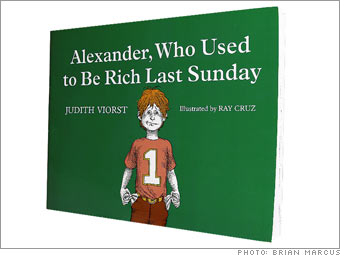
Who it's for: Four- to eight-year-olds
What it's about: In this charming story by Judith Viorst, Alexander gets a gift of $1 from his grandparents. He has lofty plans to save the money for a big-ticket itembut instead blows it all in the face of life's temptations and regrets it.
Why it works: By age four, kids are old enough to grasp the basic concepts of saving and spending, but they're not likely to sit still for a lecture on the topic.
"When children are engaged by a story and see a character's life turn this way and that, they'll learn by example," says Margaret McKeown, a senior scientist at the Learning Research and Development Center at the University of Pittsburgh.
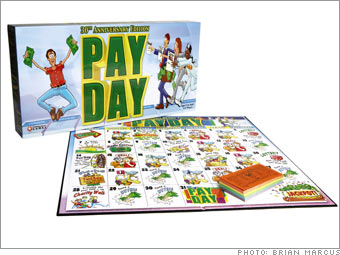
Who it's for: Preteens
What it's about: Created in 1975, this game sends each player down a 31-day path to earn and spend money - working, investing, shopping, paying bills, even gambling occasionally. The player with the most cash left at the end wins.
Why it works: Recent research has shown that, developmentally, kids are most receptive to learning financial concepts before they hit high school. But that doesn't mean they're interested. When they're having fun playing a board game, though, they won't even know they're getting a tutorial on budgeting, borrowing with interest, saving - and the perils of squandering their money.
Who it's for: Kids up to 18
What it's about: Move over, savings bonds: 529 accounts have the edge for grandparents eager to help pay Junior's college tuition. Advantages include tax-deferred growth on earnings, tax-free withdrawals and, in many states, a deduction for contributions. Compare plan details at savingforcollege.com.
Why it works: While kids may not get excited about this gift now, just wait a few years. When they owe thousands less in student loans than their college buddies do, you're sure to get plenty of appreciation.
Who it's for: Any child who has earned income
What it's about: You can invest as much as your child makes, up to $4,000 a year. Tax-free compounding over time produces a powerful payoff: A $1,500 yearly contribution will be worth nearly a million bucks in 50 years, assuming an 8 percent average annual return.
Why it works: Few teens are likely to be excited about saving their hard-earned babysitting money for retirement. So offer to match what they make in an IRA. Want another way to ramp up their enthusiasm? Slip a little cash into the gift card too.
HAZARDOUS TOY WARNINGS
Manufacturer: Wal-Mart Stores
Problem: The shaped pegs, which can come loose, may pose a choking hazard to children, according to PIRG.
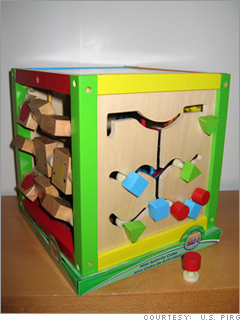
Manufacturer: Hasbro
Problem: This toy, which is targeted at children ages 3 years and older, does not violate federal safety regulations, but the smallest log could block a child's airway given its size.
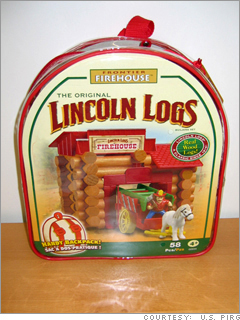
Manufacturer: MEGA brands
Problem: Even though the manufacturer issued a replacement program for this product in March, PIRG says that older versions of the toy may exist on store shelves or in consumers' homes. When swallowed, magnetic toys can cause severe internal damage, warns PIRG.
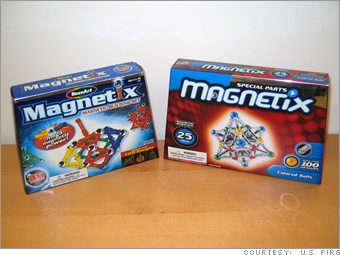
Manufacturer: Little Tikes Company/Kids Station Toys International
Problem: Held nearly a foot away from a child's ear, the volume of this toy can reach 90 decibels, according to PIRG, posing a threat of hearing loss.
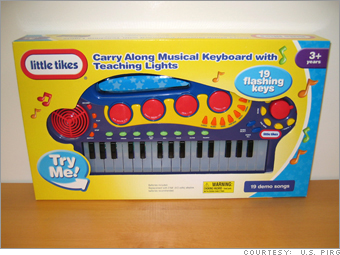
Manufacturer: Assorted
Problem: U.S. PIRG warns that the cord can wrap around a child's neck and poses a risk of strangulation when swung over the head.
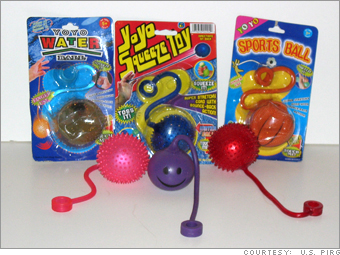
Manufacturer: Greenbrier International
Problem: The nail polish in the set contains benzene, a known human carcinogen, warns PIRG.
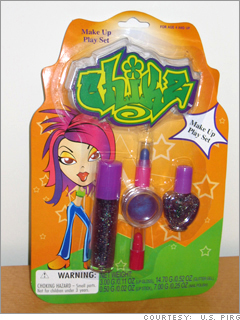
NEW YORK (CNNMoney.com) -- While shoppers will be eagerly snapping up toys for their children this holiday season, one consumer advocacy group is urging vigilance before parents spend asingle dollar.
Issuing its 21st annual "Trouble in Toyland" report Tuesday, the Washington-based U.S. Public Interest Research Group (PIRG) warned that there are many toys out there that pose significant safety hazards to children.
"While we can report substantial progress after more than two decades of advocacy on behalf of America's littlest consumers, U.S. PIRG's researchers still found trouble in toyland," U.S. PIRG Research Director Alison Cassady, the author of the report, said.
Nearly 73,000 children under the age of five visited the emergency room for toy related injuries in 2005, according to the Consumer Product Safety Commission (CPSC), and 20 children died from toy-related injuries last year.
PIRG, which visited both toy stores and retailers to find toys carrying safety risks, focused on four specific toy dangers - choking, strangulation, dangerously loud toys and those that contain toxic chemicals.
Choking on small parts, balls or balloons remains the biggest threat posed to children, according to PIRG, particularly from such toys as Wal-Mart's (Charts) Kid Connection Mini Activity Cube.
Hasbro's (Charts) Lincoln Logs Frontier Firehouse was another toy singled out by PIRG that could pose a choking hazard, while Little Tikes' Carry Along Musical Keyboard with Teaching Lights was considered a dangerously loud toy for children by PIRG.
PIRG also warned of a number of toys that contain magnets, which could cause internal harm if swallowed by a child.
"Swallowing a magnet is not like swallowing a penny," said Cassady. "Powerful magnets can wreak havoc inside the body."
The consumer watchdog also said it discovered a number of toys, including cosmetics and jewelry, that contain harmful chemicals, including high concentrations of lead that can cause lead poisoning.
The Toy Industry Association, which represents North American toymakers and distributors, issued a statement in response, claiming that reports produced by groups such as PIRG needlessly frighten parents.
"Toys are an easy target, and we are very concerned by reports that ignore or misinterpret the facts," said the industry group. "Very few of the toys named ever turn out to actually pose a safety concern when played with as designed."
"Consumers should know that toys sold in the United States are the most highly regulated and monitored in the world."
Calls to a number of manufacturers including Hasbro and Little Tikes, whose toys were cited in the report, were not immediately returned.
While most toys were produced by private firms or imported into the U.S. from foreign countries, a number of the toys cited by PIRG were produced by large U.S. companies, including Mattel (Charts).
Report: Hazardous toys to avoid this holiday season
FRIDAY, Nov. 29 (BabyCenter News) — Hazardous toys are still sold in stores across the country, says a toy safety report released last week by the U.S. Public Interest Research Group (U.S. PIRG).
The group's 21st annual "Trouble in Toyland" report provides examples of toys currently on store shelves that pose potential safety hazards and offers safety guidelines for purchasing toys for small children.
According to the U.S. Consumer Product Safety Commission (CPSC), almost 73,000 children under the age of 5 were treated in emergency rooms for toy-related injuries in 2005, the most recent year for which numbers are available. Twenty of those children died.
"Even one toy-related death is too many, because these deaths are preventable," said U.S. PIRG Research Director Alison Cassady in a prepared statement.
The "Trouble in Toyland" report warns consumers about four categories of toy dangers: choking hazards, powerful magnets, lead, and strangulation hazards.
Choking hazards
In its research, U.S. PIRG found toys for sale with small parts for children under 3 and under 6 without the required choke hazard warning. This is despite the CPSC's 1979 ban of the sale of toys for children under 3 if they contain small parts, and 1994's Child Safety Protection Act, which required an explicit choke hazard warning on toys with small parts for children between 3 and 6.
Children continue to choke on toys that meet the letter of the law. In September, Playskool recalled the Team Talkin' Tool Bench after two children suffocated when the toy's oversized plastic nails became lodged in their throats. U.S. PIRG found several toys on store shelves that have parts shaped like corks or these toy nails that could pose similar suffocation hazards.
Magnetic toys
Toymakers have started using powerful magnets in building toys and magnetic jewelry. If a child swallows more than one magnet, the magnets can attract each other inside the body and cause a bowel obstruction or life-threatening tear in the intestines.
A little boy died last Thanksgiving and many others have had life-saving surgery after swallowing magnets from MEGA Brands' Magnetix toys. MEGA Brands has modified the design of Magnetix and placed a label on the toy's packaging warning parents about the dangers of magnets.
U.S. PIRG has called on CPSC to require a warning label on all magnetic toys that tells parents to seek immediate medical attention if a child swallows magnets.
Lead in jewelry
Children exposed to lead can suffer delayed mental and physical development or even death. In February, a 4-year-old died of lead poisoning after he swallowed a bracelet charm that contained 99 percent lead. U.S. PIRG researchers went to just a few stores and easily found four items of children's jewelry that contain high levels of lead, ranging from 1.8 percent lead to 34 percent lead by weight.
"We've known for decades that lead poses serious health risks to children, so it's unacceptable that consumers can still find lead-laden children's jewelry on store shelves," said Cassady.
Strangulation hazards
Cords and elastics attached to toys can hurt children by wrapping around their neck or other body part and causing strangulation or cutting off blood flow.
One toy in particular that's caused problems in recent years is the water yo-yo: a liquid-filled ball at the end of a stretchy cord. Last month, a 5-year-old Bellevue, Washington boy almost suffocated when the toy's cord wrapped tightly around his neck several times. CPSC has recorded about 400 injuries to the eyes, face and neck since the water yo-yo ball came on the market three years ago.
"CPSC should not wait until a child dies to protect children from the dangers posed by playing with this toy," said Cassady. Her group is asking the CPSC to ban the water yo-yo immediately.
Cassady reminded parents that the toy list in the U.S. PIRG report is only a sampling of the potential hazards on store shelves.
"Shoppers should examine all toys carefully for hidden dangers before they make a purchase this holiday season," she said.
-- Jenny Des Jarlais, BabyCenter News
What you can do
• Read U.S. PIRG's full report.
• Find out what toys are ideal for your child's age.
• Check our handy recall finder to see what toys have been recalled by the CPSC.
Thursday, October 5, 2006
RECALL ALERT - Playskool's Team Talkin' Tool Bench
| Playskool Voluntarily Recalls Toy Tool Benches after the Death of Two Toddlers | ||
US and Canada, consumers should call (800) 509-9554 or use this form. WASHINGTON, D.C. - In cooperation with the U.S. Consumer Product Safety Commission (CPSC), Playskool, of Pawtucket, R.I., is voluntarily recalling about 255,000 Team Talkin' Tool Bench toys following the deaths of two young children. Playskool received reports that a 19-month-old boy from Martinsburg, W.V., and a 2-year-old boy from League City, Texas, suffocated when oversized, plastic toy nails sold with the tool bench toys became forcefully lodged in their throats. Though the toy nails are not considered a small-part, and the toys are intended for children age 3 and older, Playskool is voluntarily conducting a recall as a precaution to prevent additional incidents. The Team Talkin' Tool BenchTM is a 20-inch tall plastic toy tool bench with an animated red toy saw, a yellow toy drill and a blue toy vice. The toy talks and makes various sound effects, including tool sounds. The product also includes a toy hammer, screwdriver, two 2¼-inch plastic screws, two 3-inch plastic nails and pieces to build a small toy plane. The red Playskool logo is on the front of the brown surface of the tool bench. The toy was sold at Toys R Us, Wal-Mart, Target, KB Toys stores and various other stores nationwide from October 2005 through September 2006 for about $35. Consumers should immediately take the two toy nails away from children and contact Playskool to get information on returning the nails for a $50 certificate for a Playskool (or its related companies') product. For additional information, call Playskool at (800)509-9554 anytime, or use this form.
The U.S. Consumer Product Safety Commission is charged with protecting the public from unreasonable risks of serious injury or death from more than 15,000 types of consumer products under the agency's jurisdiction. Deaths, injuries and property damage from consumer product incidents cost the nation more than $700 billion annually. The CPSC is committed to protecting consumers and families from products that pose a fire, electrical, chemical, or mechanical hazard. The CPSC's work to ensure the safety of consumer products - such as toys, cribs, power tools, cigarette lighters, and household chemicals - contributed significantly to the 30 percent decline in the rate of deaths and injuries associated with consumer products over the past 30 years. To report a dangerous product or a product-related injury, call CPSC's hotline at (800) 638-2772 or visit CPSC's Web site at www.cpsc.gov/talk.html. Consumers can obtain this release and recall information at CPSC's Web site at www.cpsc.gov. US and Canada, consumers should call (800) 509-9554 or use this form. |
Wednesday, September 6, 2006
Thursday, July 20, 2006
The biggest car safety mistakes parents make -- and how to avoid them
The biggest car safety mistakes parents make -- and how to avoid them
By Melanie Haiken
"We were only going to the grocery store ..." "He hates to ride in his car seat, so just this once I didn't make him ..." "He was having a meltdown, so I took him out of his seat for a minute to calm him down ... " Safety experts say they hear these words all too often from distraught parents after tragedy has struck. Remember, a one-time-only lapse can result in a lifetime of regret. Each year, nearly 250,000 children suffer serious injuries in car crashes, and more than 1,600 die. In fact, auto accidents are the leading cause of death in children over age 3. But car seats and booster seats could prevent many of these tragedies. Consistent and correct use of safety seats, for instance, reduces the risk of death in a serious collision by more than 70 percent. Stephanie Tombrello, executive director of the nonprofit passenger safety organization SafetyBeltSafe U.S.A., urges all parents to get a safety seat that's convenient to use, and to make buckling your child into it such a habit that you don't even have to think about it.
Using an old or secondhand seat
That safety seat you scored at a garage sale or secondhand store for a fraction of its original cost may seem like a bargain, but it could cost your child his life. The same goes for an older-model seat given to you by a friend or a relative when her child outgrew it. Not only are used seats unlikely to come with the manufacturer's instructions (vital for correct installation), but they could be missing important parts, have been involved in an accident (even unseen damage can affect the seat's functioning), fall short of current safety standards, or have been recalled due to faulty design. To make sure your child's seat is safe, fill out the registration card when you buy a new car seat or booster seat, and mail it in so the manufacturer can notify you in case of a recall.
If you must use a secondhand seat, make sure it has the original instructions (if not, contact the manufacturer for a replacement copy), has all its parts (check the manual), has never been involved in an accident, is no more than two years old, and hasn't been recalled (click here to check a seat's recall status).
Facing your child forward too soon
Children have large heads and comparatively weak necks, so in a head-on collision (the most common type of crash) a child's head can jerk forward suddenly and violently, resulting in spinal injuries. For this reason, keep your child rear-facing position as long as possible. Just be sure that he rides in a rear-facing seat specially designed to hold children weighing up to 35 pounds or a convertible car seat that's made to hold children weighing up to 35 pounds in a rear-facing position or up to 40 pounds in a forward-facing position. (Note: The 12-months-and-20-pounds rule that many parents cite when turning their child forward in the car is actually the minimum size and age requirement.)
Though safety-seat laws vary from state to state, experts are unequivocal in their recommendations for safe riding:
• Your child should ride in a safety seat with a five-point harness until he weighs at least 40 pounds, or until his shoulders no longer fit under the harness straps. (You can use a convertible rear- and forward-facing car seat until your child hits 40 pounds or the harness system of a car- and booster-seat combo from as little as 20 pounds up to 40 pounds.)
• Your child should ride in a booster seat from the time he weighs 40 pounds (and is at least 3 years old) until he's 4 feet 9 inches tall and at least 8 years old.
Not installing your child's safety seat correctly
Your child's safety seat won't do the job it's intended to if it's not installed correctly. Among the most common mistakes: Not buckling the car seat in tightly enough, and not using the right type of seat belt to secure your child in his booster seat. So before you so much as back out of the driveway, check to see that the seat doesn't tip forward or slide from side to side more than an inch, and make sure that your child's booster is secured with a lap-and-shoulder belt.
Better yet, use the new anchoring system if you can. Since 1999, federal regulation has required most new forward-facing car seats to come with a top tether that snaps into a corresponding anchor in your car, making installation easier and more secure. But because most pre-1999 vehicles don't have the anchoring system, owners of those models may want to consider having their car retrofitted with the anchor system (check with your local auto dealership for information on cost and feasibility).
Since September 2002, all ![]() new car seats and vehicles must be compatible with the LATCH system, short for Lower Anchors and Tethers for Children (combining the previously existing top tethers with lower anchors, built into the rear of the car; some cars built between 1999 and 2002 also have the system).
new car seats and vehicles must be compatible with the LATCH system, short for Lower Anchors and Tethers for Children (combining the previously existing top tethers with lower anchors, built into the rear of the car; some cars built between 1999 and 2002 also have the system). ![]() Toddler / booster combo seats are required to have both the upper and lower attachments; booster seats are not required to have LATCH.
Toddler / booster combo seats are required to have both the upper and lower attachments; booster seats are not required to have LATCH.
Not using a locking clip or using it incorrectly
If your car is a pre-1996 model, chances are the lap-and-shoulder belts don't lock unless you come to a sudden stop. This means you need a locking clip — a small metal device that looks like an oversized paper clip — to hold the seat belt (and thus your child's car seat) tight in the event of a crash. After you buckle your child's seat tightly in place, see if you can move it more than an inch toward the front or sides of the car. If so, install the locking clip about a half-inch above the buckle (not on the other side of your child's car seat, holding the shoulder and lap belts together before they're threaded through the appropriate slot in the car seat — a common mistake parents make). If you've misplaced the locking clip that came with your car seat, contact the manufacturer to order a replacement or buy a new one at a store that carries car seats and other safety supplies.
Not securing the seat's harness correctly
You can do all the prep work in the world (shopping for just the right seat for your car and your child, placing it in the safest position in your car, and installing it correctly), but none of that will matter much if you don't buckle your child into the seat securely. To make sure the car seat harness straps are snug enough to hold your child firmly in the event of an accident:
• Buckle your child in, making sure the harness straps aren't twisted, and then use the mechanism on the front of the car seat to pull the harness tight. You should not be able to pinch any harness fabric between your fingers.
• Slide the plastic retainer clip that holds the two straps together up to armpit level before securing it. If the clip is too low, your child could be ejected from his seat in a crash.
Not buckling your child's car seat into the car
Believe it or not, many parents who are cited for car seat violations have a car seat in their car, and have their child buckled into the car seat — but have not buckled the car seat into the car. This may be the result of confusion between car seats with harnesses and booster seats (which have different anchoring systems), or the result of switching a seat from one car to another on a hectic morning. To avoid this common mistake, don't start your engine until you've double-checked that your child is not only safely secured in his car seat, but that the seat is buckled tightly into the car's seat belt system. If your child rides in a booster seat, make sure the car's seat belts are buckled around him before you take off.
Even better, use the new LATCH system to bypass your car's seat belts and attach the car seat or booster seat directly to your car. For more information, see "Not installing your child's safety seat correctly," above.
Holding your child on your lap
When your child is having a tantrum after hours on the road, it's tempting to lift him out of his car seat and hold him in your arms. The same goes when you're just making a quick dash from one locale to another with a gaggle of friends or relatives and it's easier for everyone to pile into the same vehicle than to take separate cars. This might seem safe enough (after all, you'd hold your child tight if anything happened, right?), but the truth is you can't control what your body might do in a crash. In fact, safety experts warn that even if you're belted in, your child could be ripped from your arms and thrown through the windshield by the force of a collision. And if you manage to get the seat belt around both of you, your weight could actually crush your child to death. So as much as he may scream, and as inconvenient as taking your own car is when the two of you could just hop into someone else's, never let your child ride in a moving car unless he's safely strapped into his car seat or booster. No exceptions.
Letting two kids share one seat belt
This is a big no-no; crash tests have shown that when two children ride buckled into one seat belt, their heads can knock together so hard that it's potentially fatal for both of them.
Letting your child ride in the front seat
Though he may whine and plead to ride in the front seat with you, the back seat is by far the safest place for your child, since that's where he's best protected in a head-on or side-impact collision. In fact, the National Highway Traffic Safety Administration (NHTSA) strongly recommends that all children under age 13 ride in the back seat every time they get in the car. Other tips on safe riding positions:
• If possible, buckle your child into the middle of the back seat, where he's best protected from side-impact collisions. If your child rides in a booster seat and your car has only a lap belt in the center back (which is fine for car seats but should never be used on its own with a booster seat), position your child's booster on either the right or left side of your back seat and buckle him in with the car's lap-and-shoulder belt.
• If you have a passenger air bag in your car, that's all the more reason to keep your child in the back. Though air bags are designed to reduce injuries in adults, they're actually dangerous for children. In fact, in recent years more than a hundred kids have been killed by passenger air bags, which can cause serious head and neck injuries when they inflate, especially to children in rear-facing car seats. To find out whether your car has air bags, look for a warning label on the sun visor or the letters SRS or SIR embossed on the dashboard, or check your vehicle owner's manual.
• If your child must sit in the front seat because that's the only option (if the back seat is already full or if your car is a two-seater, for example), check to see if your car's air bag has an on-off switch, and if so, turn it off. If not, have an air-bag switch installed by a car dealership or one of the specialized companies that have sprung up to deal with this situation (the NHTSA maintains a list of companies that install air bag on-off switches). If you can't disable your passenger air bag, then have the child who's most securely restrained in a front-facing car seat with a full harness (in other words, the child who's least likely to wiggle out of his restraints; or, if your passengers have all moved out of the car seat phase, your biggest or tallest passenger) ride in the front seat, and move his seat as far back from the dashboard as possible.
All contents copyright © BabyCenter, L.L.C. 1997-2006 All rights reserved.
The biggest car safety mistakes parents make -- and how to avoid them
http://www.babycenter.com/refcap/64875.html?scid=pcbulletin:20060717:0:0:0
